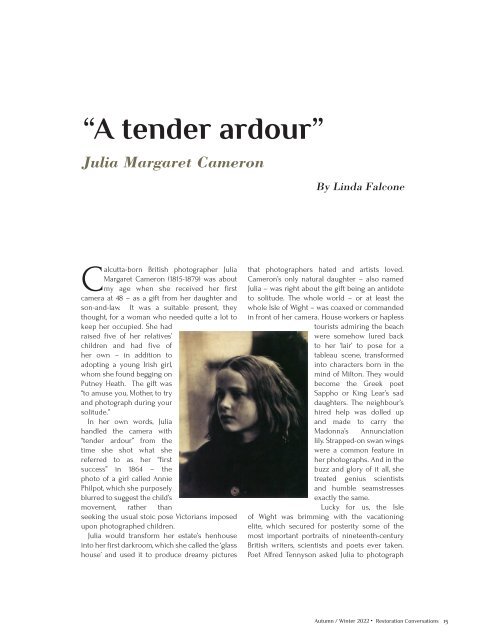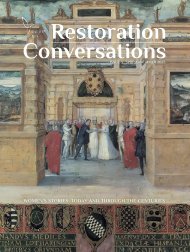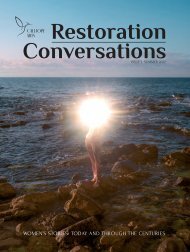Autumn/Winter 2022
Restoration Conversations is a digital magazine spotlighting the achievements of women in history and today. We produce two issues a year: Spring/Summer and Fall/Winter
Restoration Conversations is a digital magazine spotlighting the achievements of women in history and today. We produce two issues a year: Spring/Summer and Fall/Winter
You also want an ePaper? Increase the reach of your titles
YUMPU automatically turns print PDFs into web optimized ePapers that Google loves.
“A tender ardour”<br />
Julia Margaret Cameron<br />
By Linda Falcone<br />
Calcutta-born British photographer Julia<br />
Margaret Cameron (1815-1879) was about<br />
my age when she received her first<br />
camera at 48 – as a gift from her daughter and<br />
son-and-law. It was a suitable present, they<br />
thought, for a woman who needed quite a lot to<br />
keep her occupied. She had<br />
raised five of her relatives’<br />
children and had five of<br />
her own – in addition to<br />
adopting a young Irish girl,<br />
whom she found begging on<br />
Putney Heath. The gift was<br />
“to amuse you, Mother, to try<br />
and photograph during your<br />
solitude.”<br />
In her own words, Julia<br />
handled the camera with<br />
“tender ardour” from the<br />
time she shot what she<br />
referred to as her “first<br />
success” in 1864 – the<br />
photo of a girl called Annie<br />
Philpot, which she purposely<br />
blurred to suggest the child’s<br />
movement, rather than<br />
seeking the usual stoic pose Victorians imposed<br />
upon photographed children.<br />
Julia would transform her estate’s henhouse<br />
into her first darkroom, which she called the ‘glass<br />
house’ and used it to produce dreamy pictures<br />
that photographers hated and artists loved.<br />
Cameron’s only natural daughter – also named<br />
Julia – was right about the gift being an antidote<br />
to solitude. The whole world – or at least the<br />
whole Isle of Wight – was coaxed or commanded<br />
in front of her camera. House workers or hapless<br />
tourists admiring the beach<br />
were somehow lured back<br />
to her ‘lair’ to pose for a<br />
tableau scene, transformed<br />
into characters born in the<br />
mind of Milton. They would<br />
become the Greek poet<br />
Sappho or King Lear’s sad<br />
daughters. The neighbour’s<br />
hired help was dolled up<br />
and made to carry the<br />
Madonna’s Annunciation<br />
lily. Strapped-on swan wings<br />
were a common feature in<br />
her photographs. And in the<br />
buzz and glory of it all, she<br />
treated genius scientists<br />
and humble seamstresses<br />
exactly the same.<br />
Lucky for us, the Isle<br />
of Wight was brimming with the vacationing<br />
elite, which secured for posterity some of the<br />
most important portraits of nineteenth-century<br />
British writers, scientists and poets ever taken.<br />
Poet Alfred Tennyson asked Julia to photograph<br />
<strong>Autumn</strong> / <strong>Winter</strong> <strong>2022</strong> • Restoration Conversations 15





